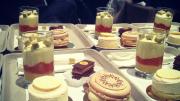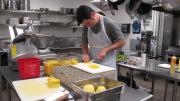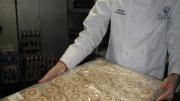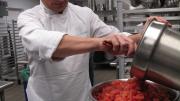Many design students might not consider consuming a creamy fresh wasabi and grapefruit confit dessert an essential part of their professional training—until world-famous French pastry chef Pierre Hermé reveals how constructing the perfect bite may not be all that different from designing a building.
Addressing some 400 students and faculty members at the Graduate School of Design (GSD) on “The Architecture of Taste,” Hermé discussed his own design process: specifically, how he creates complex and delicate layers of flavor in his various pastries, from his luxurious rose, lychee, and raspberry macarons to a deconstructed cake made of marscapone cream with caramel and amber. Hermé’s desserts are not towering, geometric structures: they are simple in design, yet extremely complex in taste.
“My ideas come from within—it is rare that I get an idea from tasting something, but rather from conversations and ideas,” Hermé said. “I write my ideas down in diagram form first and then give these diagrams to the people I work with. I have what I call a scenario of taste—I imagine this in a sequence as you bite into the cake…what happens first, what happens second, what may provide a surprise in the middle.”
Hermé was invited to the GSD by Savinien Caracostea, a second-year student who, after obtaining a bachelor’s in architecture from Cornell, chose to study at the French Culinary Institute in New York City and became interested in the relationship between design and pastry. Curious about Hermé’s work, especially the statements he had made to the media relating architecture to pastry, Caracostea traveled to France last January to see Hermé in action and hear his thoughts on the two subjects.
During the visit, Caracostea said in an interview with Harvard Magazine, Hermé showed that he had a very sophisticated way of thinking about “building” tastes by using unusual combinations of flavors and textures that make each bite unique. Thus one of his desserts—“Infinitely Lemon”—is based on using different parts of the fruit to create a true lemon experience. Drawing a contrast with the food-science programs at the School of Engineering and Applied Sciences, Caracostea said that Hermé’s work focuses less on the scientific aspect of food and more on the actual design and construction of taste.
“The construction of those flavors is analogous to the programmatic construction that takes place in architecture,” Caracostea said. “Both the world of ideas and the world of design bridge these disciplines.”
Last Friday, Hermé’s team of four pastry chefs flew from France and—helped by Martin Breslin, Harvard University Dining Services’ director for culinary operations, and his staff—set up shop in a Harvard kitchen where they worked to create the four unique desserts that were served to the audience members during the lecture. (The four desserts—the infinite lemon cake, Hermé’s famous macaron, a yuzu wasabi gelee with fresh and candied grapefruit confit and mascarpone cream, and a milk chocolate and hazelnut dessert—were served on trays to guests as Hermé spoke.)
“Pastry can be understood as the most cinematic of foods—containing in each bite a montage of distinct layers and textures,” Caracostea said. “Time seems to dilate when we are eating a pastry. By being more cinematic, pastries are also more architectural. It is perhaps for this reason that more pastry chefs have found their way into fashion and design.”











